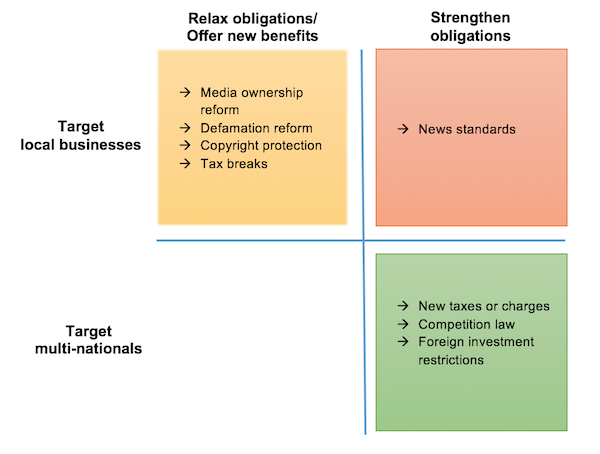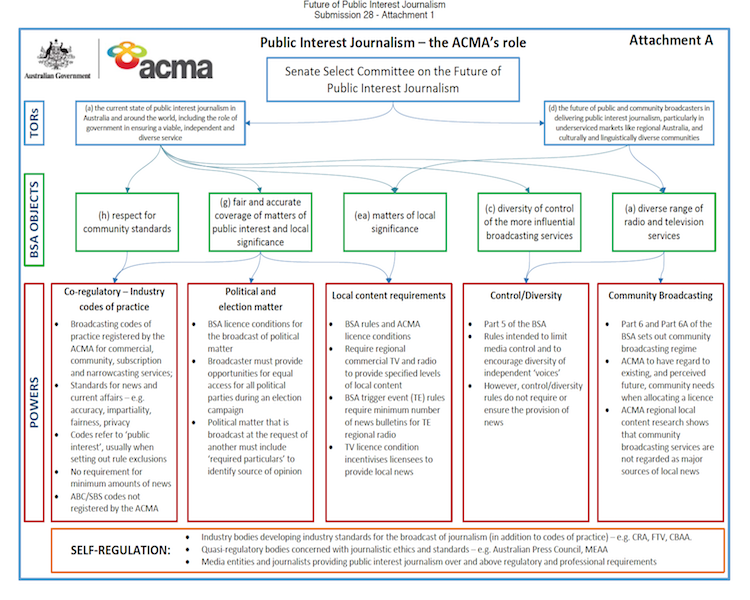In May, the Senate established the Select Committee on the Future of Public Interest Journalism after a motion from Senators Dastyari, Xenophon, Lambie and others.
The committee received just over 60 submissions by its closing date last Friday.
It now has the job of examining those submissions and formulating recommendations, which will be due by 7 December 2017.
radioinfo looks at the major submissions and summarises some of the key points below, starting with a colourful submission from Robert Webb, a self taught gentleman now aged in his 80s, who learnt much of what he knows from the media.
In more formal submissions from broadcaster representative bodies, the CBAA, IRCA and the ABC all made submissions, as did a range of other academics and interested organizations.
CBAA
By its very nature community broadcasting is vital in delivering public interest journalism, especially to underserviced markets like regional Australia, and culturally and linguistically diverse communities. Community stations provide programming that caters to the needs and interest groups of their communities and contribute to and reflect an Australia that is an open society, a strong democracy which embraces multiculturalism. Further, these stations play an important role in providing a voice for communities that aren’t adequately serviced by other broadcasting sectors. These include:
• Ethnic communities
• Educational services
• Religious communities
• Print disabled communities
• Music, arts and cultural services
• Youth and seniors’ communities
In our most recent Community Radio National Listener Survey, 48 per cent of respondents said that their key reason for listening to community radio was that stations have ‘’local information/local news’’ (48%). In regional Australia, 89% of respondents said that having access to local content is important to them. Over one third (35%) of people who regularly speak a language other than English in their household listen to community radio during a typical week. Further, community broadcasting is the largest component of Indigenous media production in Australia and half (48%) of people who identify as Aboriginal or Torres Strait Islander listen to community radio during a typical week. On a day-to-day basis, Indigenous radio is the only provider of news and information that directly affects the lives of Indigenous Australians (eg. information about community events, meetings, deaths, funerals, tombstone openings, local sporting results and coverage)…
In recent years, broadcasting media has been subject to several major technological changes which have created economic and demographic opportunities and challenges, particularly for regional media. Digital radio is the most apparent and immediate new technology offering opportunities for community broadcasting to grow its reach, particularly given 27% of Australians who live in mainland state capital cities listen to DAB+ digital radio – a cumulative audience of 3.6 million people…
Given the importance of community broadcasting and its vital role in public interest journalism it is crucial that current and future Governments provide ongoing funding certainty to support and invest in the digitalisation of community broadcasting service.
IRCA (Indigenous Remote Communications Association)
The Indigenous Remote Communications Association (IRCA) submits that any consideration of “public interest journalism” must include the need, in a democratic society, for a diversity of media that provides a full range of news, comment and opinions from mainstream and minority groups.
The role of the Aboriginal and Torres Strait Islander community media sector (radio, TV and print) is a critical component of that diversity within the Australian media landscape.
Furthermore, the way in which Aboriginal and Torres Strait Islander issues are represented in mainstream media is of vital “public interest” concern to Aboriginal and Torres Strait Islander peoples.
ABC
The Committee did not define what it means by ‘Public Interest Journalism’ so the ABC’s submission began with a definition:
For the purposes of this inquiry, the ABC considers it important to clarify that which it is sought to protect– public interest journalism. In a broad sense, journalism exercised by an independent media is regarded as a vital public asset. In 1975, Lord Simon of the High Court acknowledged the importance of an independent media to the democratic process:
“People cannot adequately influence the decisions which affect their lives unless they can be adequately informed on facts and arguments relevant to the decisions. Much of such fact-finding and argumentation necessarily has to be conducted vicariously, the public press being a principal instrument.”
Underpinning this notion is a belief in diversity– that the “public press” is not a monolithic entity but a vibrant sector comprising a variety of producers and production models… Implicit in the term “public interest journalism” is a belief that not all journalism is designed to provide a community benefit.
The ABC’s long-established position is that the community benefits from having a diverse and vibrant media sector and that public broadcasting is an important element in delivering that diversity and vibrancy. The Corporation recognises that the delivery of public interest journalism is an integral part of its remit…
Quality in-depth journalism requires significant investment in staff, time and robust editorial processes. The public broadcasting model sets up the ABC to work effectively for the public interest.
The ABC invests more in investigative journalism than any other Australian media organisation. The ABC currently employs more than 900 news journalists and presenters, approximately 140 of whom are engaged in delivering investigative journalism as the primary part of their role.
The one certainty is that the environment must involve a strong, well-funded public
broadcaster.
Google
A submission from Google says: Every day, Google helps millions of Australians and Australian businesses to harness the benefits of technology to communicate, collaborate and find the information they need…
Google’s products support and assist journalism not just because a free and independent media is a matter of vital public interest, but because ensuring credible news sources can thrive online helps us do a better job providing our users reliable information.
Google is committed to helping news publishers succeed;
– Google News provides users with convenient links to news content from more than 80,000 news publishers globally, including more than 1,000 Australian publishers;
– Google’s advertising platforms enable news publishers and other website hosts to earn revenue from ads that are displayed on their sites – 70% of display ad revenues are shared with host partners; and
– We support publishers through initiatives that tackle key issues like mobile latency.
We’re also confronting misrepresentative content online. Our mission is to make information widely available and easily accessible. But the quality of that information is just as vital, making a diverse, high quality news ecosystem of the utmost importance to Google, and to the Australian community more broadly…
In the 2016 calendar year we invested more than $400 million in our Australian operations, and our workforce grew to around 1,300 people.
In a detailed document, Google outlined how they assist news companies to make their work visible to internet users.
Facebook
Facebook’s mission is to make the world more open and connected, according to its submission to the Committee. Globally, over 70 million businesses are now using Facebook Pages, and more than 182 million people on Facebook are connected to the Facebook Page of a business in Australia.
As this Committee recognised by forming this Inquiry, technology has had a transformative impact on the reach and distribution of information, including news, around the world. The ease by which individuals and organisations can now share information online means that there is a much richer ecosystem of news for Australians, and it means that this news can reach a much broader group of people – at a fraction of the cost of distribution than it once did…
The Internet also gives everyone the potential to act like a publisher and/or journalist. With just a few clicks, anyone with a smartphone can capture and share breaking news or participate in newsworthy conversations. Against this backdrop, it is more important than ever for all players in the news ecosystem not only to harness this tremendous power to share information that may help inform local communities, but also to work toward promoting greater news and media literacy to help the Australian public to parse and evaluate the veracity of what they read online.
Other submissions
Bill Birnbauer from Monash advocated non profit independent journalism centres similar to the tax exampt model in the USA.
The stories produced by non-profit investigative news centres are published on their websites and often in the general media. There has been a profound cultural transformation in the way legacy and public media organisations regard non-profit centre stories. Today non-profit stories routinely appear in media such as The New York Times, The Washington Post, The Wall Street Journal, NPR, PBS and other key media. Collaborations between legacy and nonprofit media are commonplace.
The centres are funded in various ways:
– Predominantly by foundations.
– Donations by wealthy individual philanthropists.
– Donations by readers and individuals.
– Minor revenue from story sales, events, advertising, subscriptions.
John Tebbutt, a Senior Lecturer also from Monash University drew the attention of the committee to this report: Media Manipulation and Disinformation Online
Peter Fray and Derek Wilding from UTS Sydney tackled the question what is journalism for?
We mention this because underlying your inquiry is the concern that journalism’s capacity to enlarge the private world – and in so doing, serve the public — is under threat.
These threats range from the amorphous, fashionable and nefarious phrase of ‘fake news’ – a beast that may, hopefully, be just a passing fancy of presidents and politicians — to the serious and ongoing structural issues that fly with great force from digital disruption, in particular the undermining of journalism’s business model.
The proliferation of disinformation and the failure of the traditional news business model may be two aspects of the same phenomenon, there is no single solution. In fact, using the same tool to address both aspects could cause more harm.
The pair propose regulation in areas outlined in a chart

Commenting on the proposition that Google and Facebook make money at the expanse of other outlets that pay journalists to write news, Fray and Wilding dispelled some myths:
But if Facebook withheld the news, it would still be an exceptionally strong ecosystem of friends and family sharing. If Google withdrew Google News, consumers would still use the platform to search…
On the broader area of taxation incentives, there may be more of a case to assist and incentivise public interest journalism and/or innovation in the sector.
While the case for repeal of the two-out-of-three rule is now reasonably persuasive, this doesn’t mean all ownership rules should be repealed or that we should stop thinking about diversity. The one-to-a-market rule for commercial television licences (s 53(2)) and the two-to-a-market rule for commercial radio licences (s 54) are the critical protections that encourage three large-scale, newsgathering commercial media groups in most markets.
The complicated ‘points system’ in ss 61AG and 61AH of the BSA is less successful. Under that scheme, a radio station offering syndicated programs has the same value as a commercial television station or a daily newspaper investing in local or regional newsrooms. In our view, the community would be better served by replacing this scheme with one that identifies real sources of news and information and restricts further concentration after the changes facilitated by the current reforms.
In addition to these ownership rules, there would continue to be requirements on regional commercial television and radio licensees to provide local (regional) content. We note, however, that there is no such requirement on metropolitan licensees.
A paper from DigEcon Research pointed out that the current regulatory powers of other bodies outside the media regulators do not currently have the powers to limit media ownership. The submissions also emphasised the importance of the Public Broadcasters in maintaining quality journalism.
Irrespective of the ACCC’s powers, the provision of a news service itself, especially when free-to-air electronic media is included, is not trade and commerce. As a consequence, ‘public interest journalism’ isn’t directly covered by the definition.
Government can act to promote the public interest by ensuring merger activity protects the diversity of voices and by utilising the resources of the public broadcasters to facilitate the development of trustworthy new media.
A submission from Denis Muller from the University of Melbourne pointed to the effects of Google and Facebook on the journalism business in Australia.
In other words, Facebook and Google get it coming and going.
Failure to address this core threat will mean that no matter what tinkering is done to media ownership laws in Australia, the survival of public interest journalism in this country will remain at risk…
Facebook and Google need to be held to account for the way they exercise this power. While the Australian Communications and Media Authority might seem the logical means by which this could be done, its sclerotic and legalistic processes have proved weak in the fields of radio and television, and anyway it is bad in principle for a government agency to be the regulator of news content. So a more nimble and focused accountability mechanism funded by government but at arm’s length from it – as with the ABC and SBS – is called for.
The Public Interest Journalism Foundation argued that the crisis in public interest journalism in Australia justifies a cohesive and vigorous public response, both in providing direct and indirect government support and in taking measures to encourage private investment and philanthropic support.
control of news media operating in Australia; and
(2) the adequacy of local news services in regional and rural parts of Australia and other under-served communities. Such a review should seek community views, undertake public consultations, and if necessary conduct research into Australian news and media markets.
Researcher Jack Latimore investigated the Aboriginal media sector, submitting that, as digital technology continues to effect journalism and its relation to civic engagement and participation, First Nations news industry professionals and new media users are utilising these innovative technologies to not only contest mainstream media representations of Indigenous people, but hold Australia’s other dominant institutions to account…
What emerged from that line of thinking was a project that CAJ and the current project’s partners have come to refer to as the Wakul App…
My belief is that First Nations journalists, whether they be industry professionals or citizen journalists, are the best placed sources to report and advise on Indigenous Australia. In the heavily mediatised social and political environment of today, genuine self-determined changes in our circumstances can be effected, and representations of us corrected. It’s my hope that the next phase of development and implementation of the Wakul App contributes to this push.
Regional newspaper representative body Country Press Australia, said most of the attention about the Inquiry has been focused on the metropolitan dailies.
This is because, in regional and rural Australia, the local newspaper, combined with an online site, is usually the only source of local information. It is, in effect, the journal of record for its community. And it remains relevant.
Like all established media, regional community media is challenged by the Facebook and Google duopoly, mass information platforms that are not content-challenged, yet have the
capacity to attract significant advertising revenue. Most regional and community news media continue to have strong local advertising. Where the significant revenue decline is taking place is with national and government advertising.
National marketers do not understand the continued strength and importance of regional and community media. This is especially true of hyper-local media, such as Country Press Australia’s country non-daily publications… regional community news media circulations are decreasing at a much slower rate than the metro newspapers as city audiences take advantage of the digital alternatives for broader national and international information.
In all this, there has been a marked over-reaction from media buyers shifting away from traditional media. They see only the negatives of the metro decline and, erroneously, equate it to the much healthier, more relevant regional community media.
The result of this is that important government communications are not reaching regional communities through the best channels (although media releases still come en masse from
government agencies and MPs).
The Australian Lawyers Alliance submission mostly covered the first Term of Reference, highlighting federal laws restricting freedom of speech and undermining privacy that negatively impact the ability of journalists to report freely in the public interest.
The laws that impose these restrictions have generally been passed as a part of national security law reforms, or law reform related to asylum seekers and refugees. They generally do not meet the threshold of being necessary and proportionate burdens on freedom of speech and the right to privacy, however, meaning that they impose an illegitimate burden on these rights.
The ACMA submitted documents and a flow chart outlining its current role in monitoring and regulating areas of interest to the committee.

radioinfo will continue to cover the activities of the Committee as it moves towards its report deadline at the end of the year.

